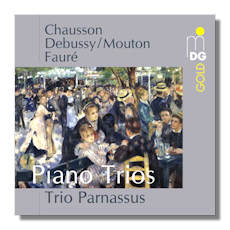
The Internet's Premier Classical Music Source
Related Links
-
Chausson Reviews
Debussy Reviews
Fauré Reviews - Latest Reviews
- More Reviews
-
By Composer
-
Collections
DVD & Blu-ray
Books
Concert Reviews
Articles/Interviews
Software
Audio
Search Amazon
Recommended Links
Site News
 CD Review
CD Review
French Piano Trios

- Ernest Chausson: Piano Trio in G minor, Op. 3
- Claude Debussy/Mouton: Piano Trio "Pelléas et Mélisande"
- Gabriel Fauré: Piano Trio, Op. 120
Trio Parnassus
Dabringhaus & Grimm MDG3031711-2 62min
Three French Piano Trios from the end of the 19th and beginning of the 20th century, but all three are very different propositions. Ernest Chausson, despite his limited oeuvre and untimely death at the age of 44 (he crashed his bicycle in Limay on 10th June 1899), is considered as one of the most important French composers of the fin de siecle. Influenced by his teacher Cesar Franck and Richard Wagner's daring harmonies, Chausson soon developed his own style that often anticipates the age of Impressionism, and his tone is elegant and fleet-footed, very impassioned and sensuous yet free of any bombastic gestures.
The Piano Trio was written in 1881 soon after finishing his studies with Massenet and Franck. The composer's self-doubt in this early period is very evident in the dark and melancholic outer movements in which the mood abruptly changes from one of sorrow to one of exuberant defiance. The cyclic conception of the work is also an important aspect that Chausson would continue to use in future compositions.
The Debussy piece is a short arrangement based on his famous 1902 opera "Pelléas et Mélisande", which remains to this day, the most renowned French stage-work of the 20th century. Seven years after the successful premiere, the Paris publishing firm of Durand & Fils commissioned Herbert Mouton to arrange the melodies from the opera for piano trio. Debussy must have known of the arrangement and most probably had given his approval to the "pot-pourri", which emerges as a highly skilful work, despite its short duration in comparison to the opera. Indeed, a year later Hubert Mouton arranged for full orchestra the same composer's "Suite bergamasque" which includes the famous "Claire de lune". Posterity has bestowed immortality on Debussy, but poor Mouton, who was professor of composition at the Liège Conservatory, the city where he was born in 1872, and an ingenious and a much in demand arranger was completely forgotten after his death in 1954.
Gabriel Fauré (1845-1924) is one of the most esteemed French composers of the last 150 years. One of the few who did not let himself be sucked into the Wagnerian whirlwind, he left behind a legacy of ineffable beauty and fragility that still hypnotizes audiences of every age. The 1922 Piano Trio is deemed to be one of the finest examples of Fauré's late style. Sedate and introverted, it flows elegantly and melodiously like his earlier works but on closer scrutiny one can detect an element of asceticism, and its concentrated and slender form is particularly evident. Fauré was practically deaf and blind when he wrote it, so the work is a lasting tribute to the composer's resilience to keep writing till the very end.
Trio Parnassus revels in the many nuances and glistening sonorities of this music, and all three renditions are full of a uniquely Gaelic characteristic that is so distinct of the period. A finely balanced and recorded disc of an engaging but somewhat unperformed repertoire that deserves to be more in the spotlight.
Copyright © 2012, Gerald Fenech





















